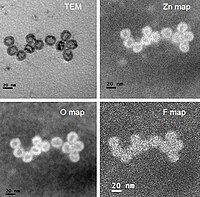
Photo from wikipedia
Undoped and manganese doped ZnS nanocrystals encapsulated with thioglycolic acid (ZnS-TGA) were synthesized and characterized with different techniques, and finally tested in the photodegradation of a methyl orange in aqueous… Click to show full abstract
Undoped and manganese doped ZnS nanocrystals encapsulated with thioglycolic acid (ZnS-TGA) were synthesized and characterized with different techniques, and finally tested in the photodegradation of a methyl orange in aqueous solution under UV and sunlight irradiations. FTIR and X-ray diffraction results confirmed the functionalization of these nanocrystal surface by thioglycolic acid and the formation of crystalline structures of ZnS and Mn-doped ZnS with cubic and hexagonal phases. Calculated average size of ZnS nanocrystals was in the range of 2–3 nm. It was observed a blue shift of the absorbance threshold and the estimated bandgap energies were higher than that of Bulk ZnS thus confirming the quantum confinement effect of charge carriers. Photoluminescence spectra of ZnS nanocrystals exhibited emission in the range of 410–490 nm and the appearance of an additional emission band around 580 nm (2.13 eV) connected to the 4T1 → 6A1 transition of the Mn2+ions. Photodegradation of methylene orange with undoped and Mn-doped ZnS-TGA nanocrystals was investigated. Dye adsorption prior to photocatalysis using nanocrystals was studied via kinetic and equilibrium experiments. The maximum dye adsorption capacity on doped ZnS-TGA was ~ 26.98 mg/g. The adsorption kinetic was found to follow the pseudo-second-order kinetic model. A statistical physics model was used to analyze the equilibrium data where the calculated adsorption energy was 17–18 kJ/mol. It was concluded that the dye adsorption was associated to the hydrogen interaction where the removal process was feasible and multi-molecular at 25 °C. The photocatalytic activity of undoped ZnS nanoparticles under UV irradiation showed better efficiency than doped nanocrystals thus indicating that manganese doping generated a dropping of the photocatalytic degradation of the dye. Dye degradation efficiency of 81.37% using ZnS-TGA nanocrystals was achieved after 6 min, which indicated that ZnMnS-TGA nanocrystals may be considered an alternative low cost and environmental friendly material for facing water pollution caused by organic compounds via photodegradation processes.
Journal Title: Environmental Science and Pollution Research
Year Published: 2022
Link to full text (if available)
Share on Social Media: Sign Up to like & get
recommendations!